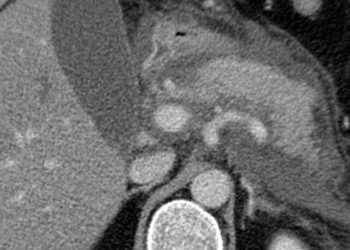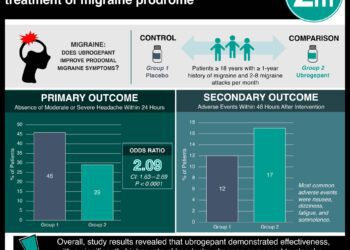Triptans may be the most effective treatments available for acute episodic migraine
1. In this systematic review and meta-analysis, the combination of triptans and non-steroidal anti-inflammatory drugs (NSAIDs) was the most effective treatment for achieving pain freedom or pain relief in adults with acute episodic migraine.
2. Triptan monotherapy was also more effective than acetaminophen and NSAID monotherapy, although there was a higher risk of adverse effects.
Evidence Rating Level: 1 (Excellent)
Study Rundown: Treatment for acute episodic migraines include over-the-counter pain medications, prescription NSAIDs, triptans, antiemetics, and dihydroergotamine, as well as the emerging gepants and ditans. This systematic review aimed to determine the advantages and disadvantages as well as cost-effectiveness of various migraine treatments. From the existing literature, the combination of triptans and NSAIDs was found to be more effective than acetaminophen, gepants, or NSAID monotherapy in achieving both pain freedom and pain relief within 2 hours of onset. Triptans combined with acetaminophen were also more effective than acetaminophen monotherapy but showed similar effectiveness to triptan monotherapy for both outcomes. Furthermore, triptan monotherapy was more effective than acetaminophen monotherapy or NSAID monotherapy for both outcomes. Assessment of pain freedom for 48 hours showed similar findings, with the combination of triptans and NSAIDs being more effective than acetaminophen, gepants, NSAID monotherapy, or triptan monotherapy. Triptans had a higher risk of adverse events compared with acetaminophen, an ergotamine derivative, and NSAIDs, although there was no difference in risk of serious adverse effects between triptans and NSAIDs. Finally, triptans were more cost-effective than gepants or ditans at 2 years and 5 years of treatment. The generalizability of this study was limited by a lack of data on differential treatment effects based on demographic characteristics or as second-line treatment; a dearth of direct head-to-head trials resulting in reliance on meta-analysis; and analysis of drug classes rather than individual agents. Overall, this study suggested that triptans and combinations of triptans were more effective than NSAIDs or acetaminophen monotherapy for treating acute episodic migraines.
Click to read the study in AIM
Relevant Reading: Canadian Headache Society Guideline: Acute Drug Therapy for Migraine Headache
In-Depth [systematic review and meta-analysis]: This systematic review and meta-analysis aimed to evaluate the efficacy and adverse effects of various medications for treating acute episodic migraine in adults. Outcomes included pain freedom at 2 and up to 48 hours, pain relief at 2 and up to 48 hours, adverse effects, and cost-effectiveness. Overall, 174 randomized controlled trials were identified, 21 of which contained head-to-head comparisons and 164 compared medications with placebo. In 124 studies that assessed pain freedom at 2 hours, the combination of triptans with NSAIDs was more effective than acetaminophen (risk ratio [RR], 1.91 [95% CI, 1.21 to 3.00]), gepants (RR, 1.96 [95% CI, 1.50 to 2.56]), and NSAIDs (RR, 1.66 [95% CI, 1.35 to 2.05]). Triptans combined with acetaminophen were also more effective than acetaminophen monotherapy (RR, 2.17 [95% CI, 1.17 to 4.03]) and NSAIDs (RR, 1.89 [95% CI, 1.06 to 3.39]) but was similarly effective compared with triptan monotherapy (RR, 1.33 [95% CI, 0.75 to 2.34]). Similar results were found for the outcome of pain relief at 2 hours. In 67 studies that assessed sustained pain freedom up to 48 hours, triptans combined with NSAIDs were more effective than acetaminophen (RR, 2.64 [95% CI, 1.43 to 4.87]), gepants (RR, 1.74 [95% CI, 1.26 to 2.39]), NSAIDs (RR, 1.70 [95% CI, 1.27 to 2.26]), and triptan monotherapy (RR, 1.26 [95% CI, 1.00 to 1.59]). In 6 studies that assessed sustained pain relief up to 48 hours, triptans combined with NSAIDs were more effective than NSAID monotherapy (RR, 1.63 [95% CI, 1.33 to 2.00]) and triptan monotherapy (RR, 1.38 [95% CI, 1.11 to 1.72]). In 138 studies that assessed adverse effects, triptans had a higher risk of adverse effects than acetaminophen (RR, 2.00 [95% CI, 1.33 to 3.01]), an ergotamine derivative (RR, 1.43 [95% CI, 0.99 to 2.07]), and NSAIDs (RR, 1.57 [CI, 1.35 to 1.83]), but a meta-analysis of 8 studies found similar risks for serious adverse effects between triptans and NSAIDs. A separate rapid review of 2176 abstracts found that triptans were more cost-effective than ditans and gepants at 2-years ($6,630 vs. $12,000 vs. $13,020) and 5-years ($16,490 vs. $28,150 vs. $30,760) for similar gains in quality-adjusted life years. Overall, this study suggests that triptans combined with NSAIDs were most effective in achieving pain freedom and pain relief, while triptans alone were also more effective than acetaminophen or NSAIDs alone.
Image: PD
©2025 2 Minute Medicine, Inc. All rights reserved. No works may be reproduced without expressed written consent from 2 Minute Medicine, Inc. Inquire about licensing here. No article should be construed as medical advice and is not intended as such by the authors or by 2 Minute Medicine, Inc.







